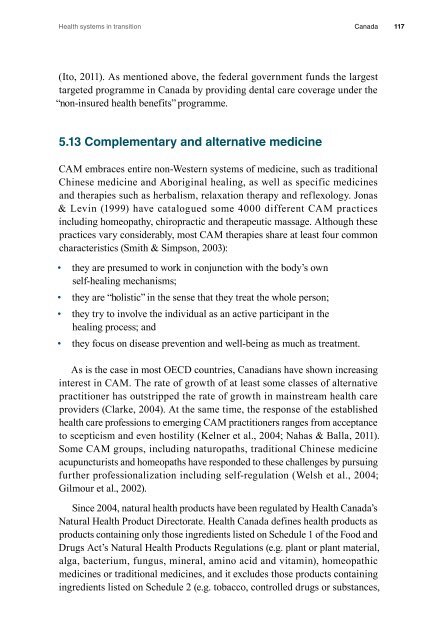Canada - World Health Organization Regional Office for Europe
Canada - World Health Organization Regional Office for Europe
Canada - World Health Organization Regional Office for Europe
You also want an ePaper? Increase the reach of your titles
YUMPU automatically turns print PDFs into web optimized ePapers that Google loves.
<strong>Health</strong> systems in transition <strong>Canada</strong> 117<br />
(Ito, 2011). As mentioned above, the federal government funds the largest<br />
targeted programme in <strong>Canada</strong> by providing dental care coverage under the<br />
“non-insured health benefits” programme.<br />
5.13 Complementary and alternative medicine<br />
CAM embraces entire non-Western systems of medicine, such as traditional<br />
Chinese medicine and Aboriginal healing, as well as specific medicines<br />
and therapies such as herbalism, relaxation therapy and reflexology. Jonas<br />
& Levin (1999) have catalogued some 4000 different CAM practices<br />
including homeopathy, chiropractic and therapeutic massage. Although these<br />
practices vary considerably, most CAM therapies share at least four common<br />
characteristics (Smith & Simpson, 2003):<br />
• they are presumed to work in conjunction with the body’s own<br />
self-healing mechanisms;<br />
• they are “holistic” in the sense that they treat the whole person;<br />
• they try to involve the individual as an active participant in the<br />
healing process; and<br />
• they focus on disease prevention and well-being as much as treatment.<br />
As is the case in most OECD countries, Canadians have shown increasing<br />
interest in CAM. The rate of growth of at least some classes of alternative<br />
practitioner has outstripped the rate of growth in mainstream health care<br />
providers (Clarke, 2004). At the same time, the response of the established<br />
health care professions to emerging CAM practitioners ranges from acceptance<br />
to scepticism and even hostility (Kelner et al., 2004; Nahas & Balla, 2011).<br />
Some CAM groups, including naturopaths, traditional Chinese medicine<br />
acupuncturists and homeopaths have responded to these challenges by pursuing<br />
further professionalization including self-regulation (Welsh et al., 2004;<br />
Gilmour et al., 2002).<br />
Since 2004, natural health products have been regulated by <strong>Health</strong> <strong>Canada</strong>’s<br />
Natural <strong>Health</strong> Product Directorate. <strong>Health</strong> <strong>Canada</strong> defines health products as<br />
products containing only those ingredients listed on Schedule 1 of the Food and<br />
Drugs Act’s Natural <strong>Health</strong> Products Regulations (e.g. plant or plant material,<br />
alga, bacterium, fungus, mineral, amino acid and vitamin), homeopathic<br />
medicines or traditional medicines, and it excludes those products containing<br />
ingredients listed on Schedule 2 (e.g. tobacco, controlled drugs or substances,
















